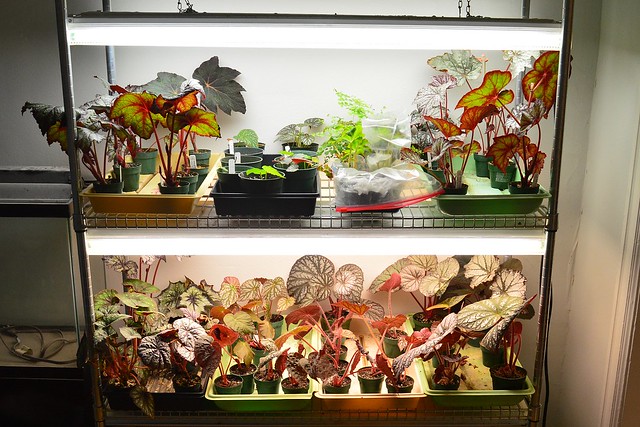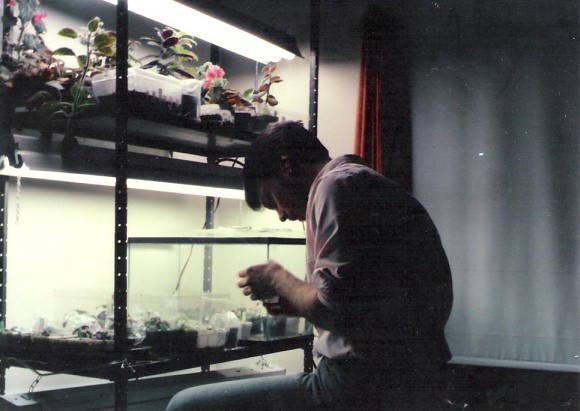 Indoor plants, 2016
Indoor plants, 2016I'm not a happy traveler; I admit it, I'm one of those people who worries whether I locked the doors or left the stove on. As a gardener, one of my more realistic worries is coming home to dead and dying plants. I've been growing plants indoors for over 40 years, originally houseplants, although now I primarily propagate plants from seeds and cuttings for planting outdoors later. I know exactly how much water each plant needs, and how often. I examine nearly every plant, nearly every day, and water each one exactly when it needs it. But what to do when I can't be home to take care of them? Below are some of the ways I help my plants (and my sanity) survive this perilous time.
 Indoor plants, 1987
Indoor plants, 1987The biggest killer when you travel is insufficient water. Your plants depend on you for all their water and if you're not around, they dry out, they wilt, and then they die. Plants dry out in two primary ways: first, they lose water from their stems, leaves and flowers through transpiration. The amount they lose by transpiration is affected by light, temperature, ambient humidity, and plant surface area. The other way they dry out is by losing water from the soil surface by evaporation. Clay pots also also lose water directly through the porous clay sides, and because of this they dry out faster than plastic pots. This is especially true of small pots that have a high surface-to-volume ratio. This is one reason why plastic pots are popular: they generally require less frequent watering than a clay pot of the same size. Either way, if you can reduce transpiration, the plant will need less water.
The second biggest killer is overwatering, which is what you will often get if you leave your plants sitting in saucers of water, or ask a well-meaning friend or family member to water for you. This is one reason why I don't like to have plantsitters, but if you must, see below.
1. Get rid of plants. Do you really need all those plants? At any given time I have a plant (or two, or three) that's just hanging on, but that I can't quite bring myself to discard. You know the plant: not quite dead, you know it would be beautiful if it were doing well, but it's clearly not a happy camper and possibly not long for this world. Well, this is the time to do the dirty deed. Give away or throw away the plants that are on their last legs, aren't doing well, that demand too much attention, or that you just don't love. And don't feel guilty about it! They aren't puppies and kittens. Fewer plants, and especially fewer plants that need constant attention, will make your life a whole lot easier. More importantly, this will also make things easier for your plant sitter if you need one.
2. Repot. I cannot stress this enough: plants that dry out quickly are often potbound and will benefit from repotting anyway. A week or two before traveling, I identify any plants that are due for repotting. In a pinch, I'll repot the plants the day before I travel. This isn't ideal, because I'm usually busy preparing for my trip, but it will nearly always get them through the next several days without attention. If any of your plants are in clay pots, this is a good time to switch to plastic.
3. Prune. And if the plant will tolerate it, prune hard. This is a quick and effective way to reduce the leaf mass, which will reduce the plant's surface area and thus transpiration. Most of your plants probably need pruning anyway but save those cuttings! (See #11 below)
4. Remove buds and flowers. Plants that are blooming heavily dry out faster because they lose water by transpiration through buds and flowers, which increase the plant's surface area. You won't be home to enjoy them anyway, so remove all buds and flowers a day or two before you leave.
5. Defoliate. Remove the oldest leaves, or any that are beginning to yellow and senesce. Some plants can survive with most or even all their leaves removed. As with pruning, this reduces the plant's surface area but far more drastically. It's not ideal for the plant, but it's better than coming home to a dead plant in a pot of bone-dry soil.
6. Cut to the ground. Some plants are so easy and so fast-growing that you can literally cut them to them down to stubs, and they will come back in a few days or weeks. In the meantime, they will need far less water than usual.
7. Force dormancy. Some plants have a natural dormant period when they stop growing, drop some or all of their leaves, or die to the ground entirely. Most have lower water needs during this period. If you can time their dormancy to fall during your travel, the plants will need no care whatsoever. In many cases, this is as simple as cutting back on watering for the days or weeks leading up to your trip.
8. Cut back on light. Move plants away from windows, close curtains or blinds, and reduce the daytime setting on automated plant lights. Most plants can survive for at least a few days with little or no light, and both low light levels and short days help cut down on transpiration.
9. Turn down the thermostat. Lower temperatures mean slower plant growth, slower metabolic activity, and thus less transpiration. This is easiest (and most cost-effective) in the winter; keeping the temperature low in the summer may jack up your air conditioning bills a bit, but be aware that the warmer your house, the faster your plants will dry out.
10. Enclose. This is my own method of last resort and is only practical with smaller plants. Enclosing plants (e.g., in a plastic bag) increases humidity, reduces transpiration, and keeps the soil from drying out as quickly. The down side is that if the plant stays too wet it may rot or mildew. The high humidity also encourages soft, weak growth that will immediately shrivel up when you return home and remove the enclosure. If you must, use an enclosure that has some openings to allow air flow and keep the humidity somewhere below 100%. For my tender seedlings, I have a clear plastic dome with adjustable openings that fits over the plant trays.
11. Propagate. Remember all those stems and leaves you took off the plants up above? They can often be potted up and placed in plastic bags. They will keep for weeks like this as long as they have light (but not direct sun!), and by the time you get home they'll be rooted and ready to grow. It's good insurance against losing the parent plant, and if you end up with extra plants, you can share them with your plant-loving friends.

Don't wait until the last minute to figure out what you're going to do. You know your own plants better than anybody else does, so you know which plants are going to cause problems. Two or three weeks before an extended period away from home, evaluate your plants and determine which ones need the most attention. I like my plants to be able to fend for themselves for at least 5 days, the average length of many of my trips. Even under normal conditions, few of my plants need water more often than every 3 or 4 days. These tips are primarily for indoor plants, but many of them will help with outdoor container plants as well. They will also help make things easier for a plantsitter, should you need one. Many of these suggestions are not ideal horticultural practices; the goal is not your plants thriving but simply surviving until you can get home and nurse them back to health.
Finally, if you're traveling for any extended period, you may have no choice but to ask somebody to water your plants. I don't like doing this; I may not consider my plants a burden but for anybody else it's a huge chore and a very big favor to ask. They don't know my plants, they may not grow plants themselves, and their tendency will be to overwater. If it comes to this, my advice is to keep it as simple as possible. I once felt my eyes rolling involuntarily as I listened to a friend complain that she had left a detailed, 3-page plant-by-plant list of instructions for her plant sitter, which—surprise, surprise—were not followed to the letter. I like to tell my sitter to water all my plants, just once, all on the same day. This might be a bit too much water for some, and not enough for others, but in the short term it will be sufficient for most. I also instruct to water all the plants lightly, then go back around and give a little more water to any plants that don't have water coming out the bottom; this helps prevent overwatering.
As a last resort, if you travel often or for long periods, you may want to invest in an automatic watering system. This is something I have no experience with, so I can't offer any advice. Otherwise, you might consider growing lower-maintenance plants. Most cacti and succulents, and many orchids, can easily survive extended periods without water. Maybe these are the plants for you.
I hope this will help get your plants through your next vacation. Please comment below with any tips or tricks of your own!

A very handy and informative post John! And entertaining to read too! Can't agree more with your points, coming from fellow worry wart travellers as well...
ReplyDeleteReally good information, although #11 just seems like it will make your next trip even more stressful. ;)
ReplyDeleteHow to take care of plants during holidays? Choose the pots; make sure there are holes in the bottom of your container to allow water to flow out freely, etc.
ReplyDeleteThis comment has been removed by a blog administrator.
ReplyDeleteDefinitely I should get rid of some of my plants. I have a cat and owing to the fact that most of my plants are poisonous for him I have to keep them in one room and there is so many of them. What I can keep in kitchen are only herbs (which also sometimes are bitten!). I love every variety of basil but my favourite one, sweet basil, makes the best job. I buy 650 seeds of it from https://gardenseedsmarket.com/sweet-basil-seeds-ocimum-basilicum.html and they are enough for me for a long time. Its benefit it definitely its strong aroma which perfectly fits in most of my dishes!
ReplyDeleteGreat article
ReplyDelete